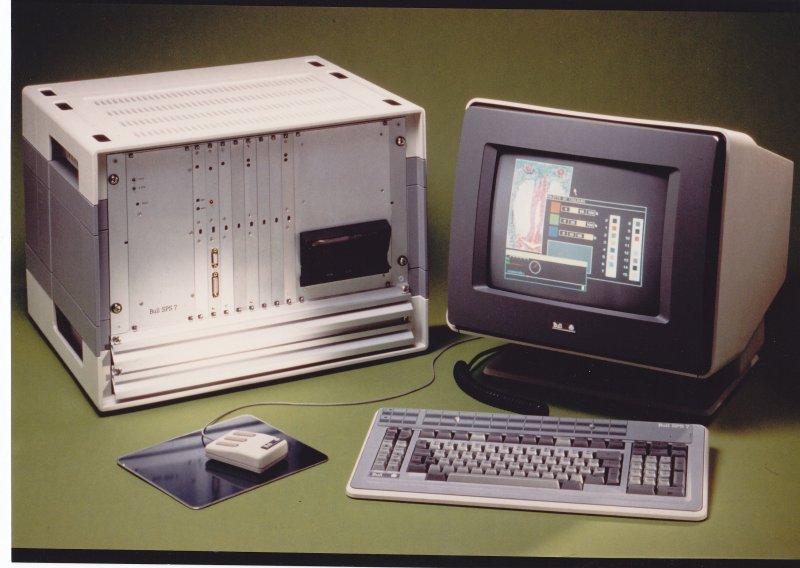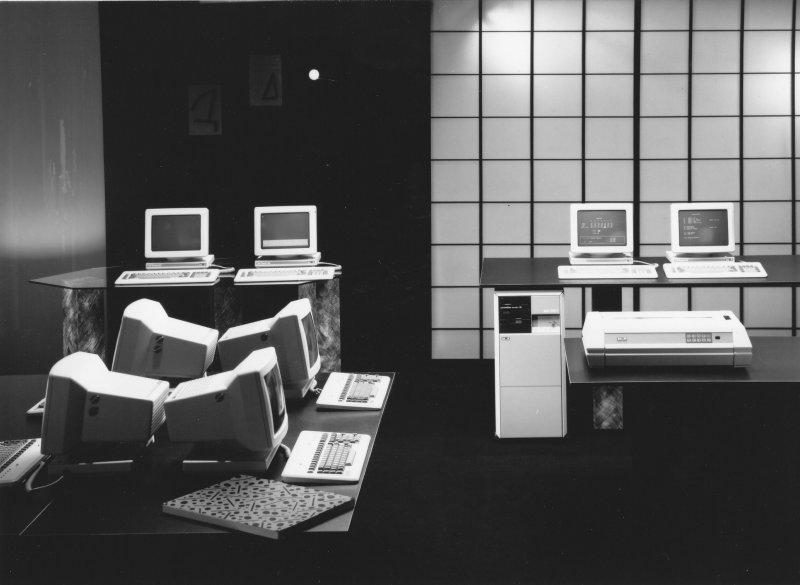
Bull
SPS-7
| Introduction Parmi les produits UNIX développés par Bull à partir du microprocesseur Motorola MC68000, on notera la part importante jouée par le mini-ordinateur SPS-7 dérivé du projet SM-90 conçu en 1980-1981 par le CNET centre de recherche des PTT. La SM-90 a été conçue et fait l'objet de prototypes par le CNET et sa
licence a été offerte aux constructeurs français d'ordinateurs de
l'époque (Bull, Thomson Telephone, TRT, CSEE, ESD Dassaut, SMT-Goupil et
Telmat) . Ceux-ci araient la responsabilité d'industrialiser le produit
et d'en créer des dérivés. Bull, en train d'être reconnu comme le champion national, se sentit obligé de commercialiser la SM-90 et d'en dériver des versions qu'il vendra sous le nom de ligne SPS-7. Projet SM-90 La SM-90 fut conçue par le CNET à Lannion pour les besoins interne des télécommunications françaises succédant à la SM-80 dont 6000 exemplaires ont été produits à la fin des années 1970. Le prototype de la SM-90 fut disponible en 1982. La licence fut acquise sur une base non-exclusive par Bull-SEMS en juin 1983, peu après son intégration dans le Groupe Bull. L'autre constructeur exerçant effectivement la license en fut Telmat. Une organisation, créée par le Ministère de l'Industrie fut en charge de superviser le programme dont le CNET, l'INRIA et Bull-SEMS étaient chargés des extensions. Le contrat de license donnait à Bull-SEMS un délai d'un an pour "industrialiser" la SM-90. Architecture Le noyau du système était le microprocesseur MC-6000 à 8 MHz. La caractéristique essentielle était un bus original le SMBus en fond de panier permettant à plusieurs cartes processeurs de partager une mémoire commune tout en ayant également une mémoire locale (RAM ou EPROM). Matériel Le bus permettait l'interconnexion d'une ou plusieurs cartes processeurs, de une ou plusieurs cartes mémoire DRAM (512 Ko chacule), de cartes SCSI, d'interface GPIB et de cartes d'interfaces téléphoniques. Logiciel Le système d'exploitation était un portage de l'UNIX V7 de AT&T. Le logiciel libré avec la SM-90 oncluiat l'Atelier de Génie Logiciel ALIS qui était centré autour de langage Pascal-S qui mettait l'emphase sur la programmation modulaire. D'autres langages UNIX dont bien entendu C, étaient aussi suportés par ALIS.
Le SPS-7 Pour tirer de la SM-90 un système UNIX fiable et compétitif, Bull
reprit complètement le dossier matériel dans son laboratoire
d'Echirolles, ce qui en retarda la mise sur le marché. La véritable livraison du SPS-7 fabriqué à Echirolles n'intervint qu'en 1985. Parmi les évolutions d'architecture importantes figure un mécanisme d'adressage virtuel pour supporter plus d'espace que permis par la mémoire physique.
Modèles SPS-7 SPS-7/50 et SPS-7/70 ces deux modèles introduidirent le microprocesseur MC-68010 SPS-7/300 Ce modèle incorporait le 68020 à 16.67 MHz et était associé au coprocesseur de gestion de la virgule flottnate MC-68881. La capacité du bus fut étendue à 10 cartes d'entrées-sorties. La capacité des cartes mémoire fut étendue à 4 Mo.
Le SPS-7/75 fut annoncé comme un système temps réel basé sur le 68020. Le DPX-2000 et le Questar 700/10 furent des avatars du SPS-7/300 Logiciel Le système UNIX V7 fut remplacé par UNIX System V , mais fut renommé SPIX et commercialisé exclusivement par Bull, sous forme d'un système d'exploitation suppportant jusqu'à 32 utilisateurs. Outre TCP/IP SPIX supportait l'architecture Bull ISO/DSA ainsi que le système de courrier X400. SPIX supportait aussi les terminaux X (à travers X-Windows) et des terminaux graphiques GKS et GDS. L'atelier de génie logiciel ALIS fut rebaptisé SPALIS. Un port d'Oracle sur SPS-7 a été aussi réalisé. Le Lisp v15.3, le dialecte INRIA de LISP fut porté sur SPS-7 et en conjonction avec KOOL aida à promouvoir le SPS-7 come station de travail dans le marché , alors prometteur, de l'intelligence artificielle. SP Prolog (version Edinbourgà compléta cette offre.
Conclusion. Après l'acquisition par Bull des cativités ordinateurs de Honeywell, le SPS-7 entrait en concurrence avec le produit italien similaire le XPS-100. En 1990, la ligne Bull SPS fut abandonnée au profit d'une ligne "unifiée" DPX-2. Deux ans plus tard, compte tenu de la défaillance de Motorola à poursuivre la ligne de microprocesseurs 680x0, Bull se mit à offrir le DPX-20 une version OEM de l'IBM RS-6000. |
Introduction
Among the UNIX products developed by Bull from the Motorola MC68000 microprocessor, the SPS-7 took an important part. It originated from the SM-90 project designed in 1980-1981 by the PTT research center CNET. The SM90 has been designed and prototyped by CNET and its license had been offered to the French computer manufacturers ( Bull, Thomson Telephone, TRT, CSEE, ESD, SMT-Goupil, Telmat) to industrialize the product and to made derivative. This minicomputer could be used as the basis of a workstation or a small server and could be used for controlling industrial processes. Bull, as it was the recognized national champion, felt itself constrained to market the SM-90 and develop derivatives that it market under SPS-7 product line. SM-90 project The SM90 was designed by CNET at Lannion for the internal needs of French Télécomunications as a minicomputer succeeding to the SM-80 (6000 SM-80 systems have been produced in the 1970s). The SM-90 prototype was available in 1982. The license was acquired in a non-exclusive basis by Bull-SEMS in June 1983, soon after its integration inside Bull. The other manufacturer that exercised the CNET license was Telmat. An organization, created by the French ministry of Industry, was to oversee the SM-90 program, with CNET, INRIA and Bull-SEMS to design extensions. The contract gave to SEMS a one-year lead time to "industrialize" the SM-90. Architecture The system core was the Motorola MC-68000 at 8 MHz. The most original part of the architecture being the SMBus allowing several processors to share a common memory, while having also a local RAM or EPROM memory. Hardware The bus interconnected the processor board(s), one or several 512 KB DRAM boards, SCSI boards, GPIB interface boards and telephone lines boards. Software The operating system was a port of AT&T Unix V7. The software delivery included the ALIS software factory ("Atelier de génie logiciel") that was centered around the language Pascal-S, emphasizing modular programming. Other UNIX languages were also supported by ALIS.
SPS 7 While SPS-7 is a real derivative of SM-90, the project was not just the industrialization of the CNET prototype, but the recreation of a competitive UNIX system, from the SM-90 architecture. Consequently, the project took time and delayed the actual entry of Bull in the UNIX market, discouraging somewhat the sales forces that have been sold UNIX by the upper management of the company. SPS7 has been formally introduced by Bull in 1985. It was manufactured in Echirolles. Architecture As a typical time-sharing application did require more address space than a real memory DRAM could offer board, the memory addressing mechanism was extended to support paging.. Hardware Models SPS 7/50 and SPS 7/70 Those models were evolved from SM-90 by introducing the 68010 microprocessor. SPS 7/300 The SM-90 microprocessor was changed in SPS-7 into a MC68020 at 16.67 MHz. It was associated to the floating point coprocessor MC68881. The capacity of the bus was extended to up to 10 I/O boards. The memory board was extended to 4MB The SPS 7/75 was announced as a 68020 based real time system (without virtual memory ?) The DPX2000 and the Q700/10 were versions of the SPS 7/300 Software The operating system was replaced by Unix
System V, that was renamed as SPIX, a Bull proprietary
name, supporting up to 32 user processes. The choice of System V was
oriented by the strategic choice of Bull to promote X-Open standards. SPS-7 supported windowing terminals through X-server and graphic terminals through GDS and GKS servers functions. ALIS software factory was renamed SPALIS. Oracle data base system was also ported on SPS-7 Le Lisp v15.2, the INRIA dialect of LISP, was ported to SPS-7 and in conjunction with KOOL helped the promotion of SPS-7 in the artificial intelligence market. It was complemented by SP Prolog a version of the AI language, in its Edinburgh version. Conclusion Bull, after acquiring the Honeywell business, had seen SPS-7 competing with the Italian designed XPS-100. It discontinued the SPS-7 in 1990, announcing a "unified" DPX-2 Unix line that was soon (in 1992) to be also replaced by DPX/20 an OEM version of IBM RS-6000.
|
|
from a paper of Jean-Louis Guédé


une configuration du Questar 700